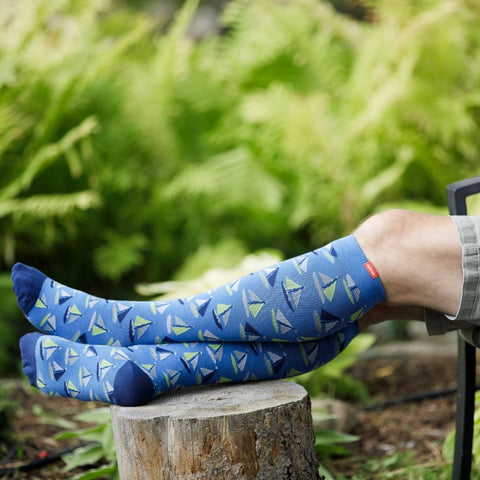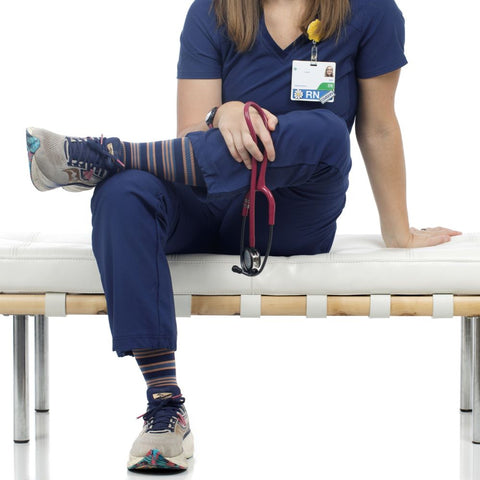High Arch Foot Problems: Can Compression Help?
High arch foot problems often start when you are young because they are a genetic condition. High arches in your feet are not necessarily a problem, especially if your feet have been like this your whole life. However, pain and other foot problems can be caused by high arches, and this is what we’ll investigate in this article.
So, what foot problems do high arches cause and how can you manage them? Read on to find out the typical high-arched foot issues people encounter, what causes them, and what strategies you can use to soothe and/or reduce your risk of pain with high foot arches.
Understanding High Arch Foot Problems
High foot arches refer to when very little or no part of the middle of your foot touches the ground when you stand with your feet relaxed; only the heel, toes, and forefoot touch the ground in people with high foot arches. High arches may become a problem, especially if you do not find the right footwear, according to a scientific report. People with high arch foot problems can experience rubbing and pain in different types of footwear as well as problems with foot mobility and even calf pain.
What are High Arches and What Causes Them?
The concept of “high arches” refers to the shape of the foot where the inner middle part of the foot doesn’t touch the ground when you stand up while positioning the weight of your body on your heels and balls of your feet. One scientific study found that high arches are becoming more common. You can easily identify this when you come out of the shower, by walking barefoot and seeing the marks you leave on the towel.
Of course, slightly high arches do not frequently cause issues, if you find the right foot support. In fact, most people fall somewhere on a spectrum between flat feet and high arches. Very often, high-arched foot problems are genetic. Sometimes, however, they can also be caused by injuries or neuromuscular diseases, depending on which side of the foot drives the height:
- Forefoot driven pes cavus is a medical term for feet that do not flatten when you put weight on them. This can be the result of muscular imbalances and/or neurological disease. For example, weak lower leg or foot muscles (specifically tibialis anterior or foot muscles) can trigger it.
- In such cases, the Achilles tendon can be impacted by the foot biomechanics, which can lead to pain in that area.
- The affected person’s gait (AKA walking pattern) changes.
- There is a negative impact on shock absorption, which increases the likelihood of developing plantar fasciitis, according to a scientific report.
- Hindfoot driven pes cavus is caused by injuries to the muscles or bones, which can cause you to walk differently. Sometimes, ankle osteoarthritis patients end up with prolonged compensation that can lead to foot deformity over time (see this clinical study for more information).

Common Symptoms of High Arches
There are a range of possible symptoms when high arches have become painful and problematic. They can include:
- Frequent ankle sprains
- Plantar fasciitis
- Arch pain and generalized foot pain
- Occasional knee pain
As you might expect, pain in the foot will be the most obvious and common symptom. You may also begin to find your usual shoes uncomfortable. Some patients also complain of calluses or blisters, caused by uncomfortable rubbing between the foot and footwear.
Additionally, you can experience instability in the foot muscles and a weakness in the foot and ankle muscles (which can then be linked to ankle sprains). It is important to know that runners, avid walkers, or hikers with high arches are at a higher risk of developing injuries or foot and ankle pain.
Finally, hammertoes (when especially the second toe becomes bent and can be painful) or claw toes (where the toes stay clenched) are also connected to high foot arches.
Relieve foot pain with compression socks.

Causes of High Arch Foot Pain
Higher arches do not necessarily cause foot pain or a serious condition. Many people have slightly higher arches without any symptoms. Taking the right steps to support your feet is the best way to prevent high arch foot pain. Some runners benefit from additional support in the arch of their foot, although this has been disputed as some styles of support may cause weakness in the foot muscles.
However, if you suffer from foot pain caused by your arches being higher, either because of congenital reasons or after injury or disease, here are problems you can expect if you have high foot arches.
Impact of High Arches on Posture and Gait
Walking and/or running with high arches can lead to pain in the foot and ankle as well as possible discomfort in the upper leg. People with high arches - especially those whose feet have changed after a traumatic injury - tend to clench or fold their toes when walking to stabilize themselves. This can lead to conditions like hammertoes and to irregular walking or running gait.
The direct consequence of pes cavus on gait is that there is a compensation leading to locking the middle of the foot, reducing flexibility, and reducing the foot’s ability to appropriately absorb shock from walking or running. This can cause foot cramps and pain. In more severe cases, it can lead to conditions like metatarsalgia (pain in the ball of the foot).
Soothe aching feet by relaxing in graduated compression stockings.

Increased Risk of Injuries
Having high arches can cause cramps, blisters, calluses, and foot pain. It can also lead to more severe injuries because of the change it causes in your walking or running gait.
Increased foot stiffness and pain may also reduce balance overall. This can increase your risk of developing a sprained ankle or injured calf muscle when walking. Moreover, prolonged changes in your walking gait may increase the risk of injury to your shins, ankles, and knees. People frequently complain of tight calf muscles or shin splints as well.
Another issue to consider is running or walking with high arches and how your footwear may affect this. Your shoes will tend to be worn more on the outside of your feet and you may find that you develop calluses on the external part of your foot because of how you land. But this is highly personal, and you should assess your gait with a professional to find the best footwear for you.
Can Compression Help with High Arch Foot Problems?
Compression socks may be able to help improve foot pain and other problems caused by high arches. One scientific report says that compression socks and stockings can reduce inflammation and improve blood circulation, which may reduce pain caused by high foot arches.
Living with high-arched feet can cause pain and tightness in your calf muscles and pain in the knees as well. Having high arches leads to supination (where your feet land predominantly on the outer edge), which can place more strain on the iliotibial (IT) band (your outer leg muscle) and the knees, too.
Much of the pain and discomfort in the knees, IT band, calf muscles, and ankles may be caused by local inflammation due to increased wear and tear from foot problems. Wearing compression socks when you’re recovering from exercise, or pre-emptively during your runs and walks, boosts local blood flow and reduces inflammation and pain in these parts of the legs. Moreover, compression socks help relieve pressure on your muscles and tendons, which can also relieve soreness linked to high arches.
Finally, wearing compression socks may also improve your balance and feelings of stability when walking, according to a clinical study. The tight grip from compression wear is supportive and reassuring, while also shielding the feet from rubbing and blistering.
Avoid blisters when hiking by wearing warm and supportive compression socks.

Choosing Compression Socks for High Arch Foot Pain
High arch foot pain cannot be remedied completely through compression therapy. However, wearing compression socks might relieve pain and discomfort, offer protection from blisters and calluses, and boost blood flow to soothe muscles and joints.
With that in mind, here are the key factors to consider when buying a pair:
- Sizing. Compression socks are only effective if they are tight enough to apply the pressure needed to stimulate blood flow in the lower legs. Many people make the mistake of going too loose with their first pair, which may prevent you from getting any benefits from wearing the socks. You can even run the risk of your socks rolling down your leg and becoming uncomfortable or painful. Use a sizing guide to ensure the right fit for you.
- Fit. In addition to buying the right size, you also need to ensure that compression socks are worn correctly. This means fitting them properly against the toe and heel extremities and pulling knee-high socks up to just under the knees. You can find out more information about putting on socks correctly here.
- Choice of material. Depending on what you’re planning to do while wearing them, it’s important to choose your compression sock material based on how breathable, comfortable, or flexible it is. For example, merino wool is great for hiking and running because it is both breathable and moisture-wicking, while nylon is flexible and sleek, making it a good choice for dancing or indoor sports. Of course, cotton is a versatile pick for all-day wear.
- Compression levels. Not all compression socks are the same - the tightness varies depending on compression levels, expressed in mmHg. Everyday wear (15-20 mmHg) is good for pretty much any first-time user scenario, but consult with your doctor before opting for higher pressure levels.

Complementary Strategies for Managing High Arches
In addition to medical interventions (if needed) and compression wear, you can improve your foot stability and reduce pain by increasing muscle strength and flexibility and adding in some support for your high arches.
Foot Exercises and Stretches to Improve Flexibility and Strength
Improving foot strength is a great first step towards managing high arches. According to a scientific report, appropriate foot and ankle exercises could improve your stability and performance, whether running, hiking, or walking for fitness. Here are exercises to try:
- Roll your feet on a small exercise ball, pushing down to loosen any tensions on the ball of the foot
- Create a “short foot” by focusing on bringing the toes and the heels closer together, without flexing your toes (repeat 5-10 times on each side)
- Move your big toe inwards, independently of the rest of your toes; also lift and lower it on its own; then lift and lower the other 4 toes while keeping the big toe on the ground; repeat several times on each side
- Create a “wave” with your toes, waving them from smallest to largest in both directions
- Massage the ball and arch of your foot with your knuckles, gently pressing in to relieve tensions.
Orthotic Options for Additional Support
There are custom-designed orthotics that can support high arches for extra cushioning and support. These can be placed into your shoes and are quite seamless. You should consult with a medical professional to see if they could be right for you.
Footwear Considerations for High Arches
Some people can benefit from wearing running or walking shoes with specific support for high arches. Shoes with a wider base and higher top can also improve stability and protect your ankles. However, they can also reduce your foot strength as you rely on the shoe to make up for the weaker arch - so you should use shoes and orthotics in cases where you cannot build your foot strength, or in a complementary fashion.
Talk to Your Doctor
Regardless of your situation, it’s important to cater to your foot specifics and to your lifestyle and overarching medical conditions. This is why you should start by having a doctor examine your high arches to decide the best course of action.
References
Woźniacka, R., Oleksy, Ł., Jankowicz-Szymańska, A., Mika, A., Kielnar, R., & Stolarczyk, A. (2019). The association between high-arched feet, plantar pressure distribution and body posture in young women. Scientific reports, 9(1), 17187. Read it here.
Woźniacka, R., Bac, A., Matusik, S., Szczygieł, E., & Ciszek, E. (2013). Body weight and the medial longitudinal foot arch: high-arched foot, a hidden problem?. European journal of pediatrics, 172(5), 683–691. Read it here.
Seaman TJ, Ball TA. Pes Cavus. [Updated 2023 Aug 8]. In: StatPearls [Internet]. Treasure Island (FL): StatPearls Publishing; 2024 Jan-. Read it here.
Latt, L. D., Jaffe, D. E., Tang, Y., & Taljanovic, M. S. (2020). Evaluation and Treatment of Chronic Plantar Fasciitis. Foot & ankle orthopaedics, 5(1), 2473011419896763. Read it here.
Wang, B., Saltzman, C. L., Chalayon, O., & Barg, A. (2015). Does the subtalar joint compensate for ankle malalignment in end-stage ankle arthritis? Clinical orthopaedics and related research, 473(1), 318–325. Read it here.
Williams, D. S., 3rd, McClay, I. S., & Hamill, J. (2001). Arch structure and injury patterns in runners. Clinical biomechanics (Bristol, Avon), 16(4), 341–347. Read it here.
Menz, H. B., & Lord, S. R. (2001). Foot pain impairs balance and functional ability in community-dwelling older people. Journal of the American Podiatric Medical Association, 91(5), 222–229. Read it here.
Bieuzen, F., Brisswalter, J., Easthope, C., Vercruyssen, F., Bernard, T., & Hausswirth, C. (2014). Effect of wearing compression stockings on recovery after mild exercise-induced muscle damage. International journal of sports physiology and performance, 9(2), 256–264. Read it here.
Derby, H., Conner, N. O., Talukder, A., Griffith, A., Freeman, C., Burch, R., Simpson, J. D., Goble, D. J., Knight, A. C., & Chander, H. (2022). Impact of Sub-Clinical and Clinical Compression Socks on Postural Stability Tasks among Individuals with Ankle Instability. Healthcare (Basel, Switzerland), 10(7), 1271. Read it here.
Lim, C. S., & Davies, A. H. (2014). Graduated compression stockings. CMAJ: Canadian Medical Association journal = journal de l'Association medicale canadienne, 186(10), E391–E398. Read it here.













Leave a comment